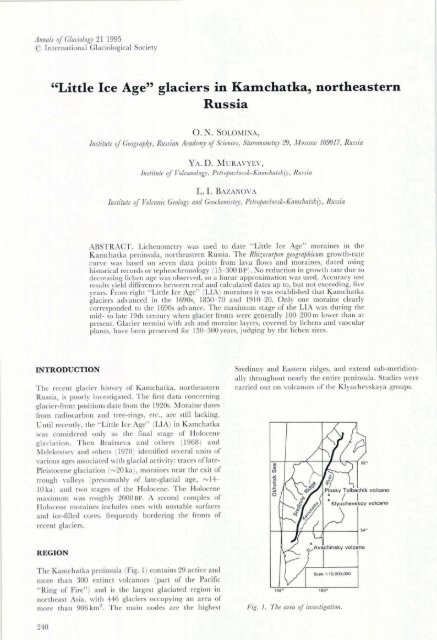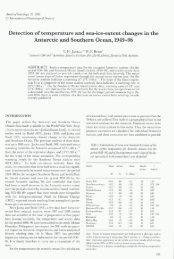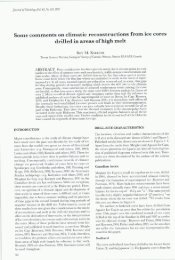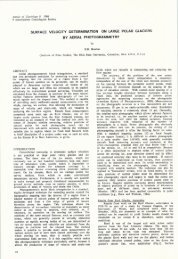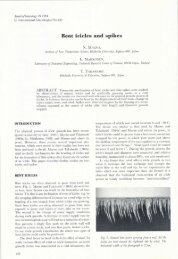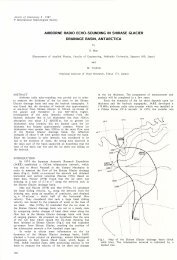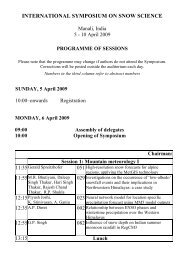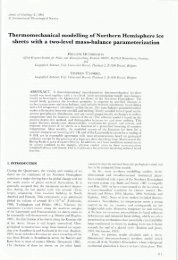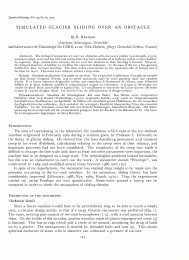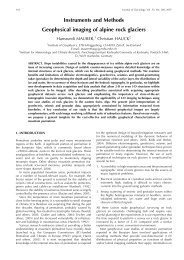"Little Ice Age" glaciers in Ka:mchatka, northeastern Russia
"Little Ice Age" glaciers in Ka:mchatka, northeastern Russia
"Little Ice Age" glaciers in Ka:mchatka, northeastern Russia
You also want an ePaper? Increase the reach of your titles
YUMPU automatically turns print PDFs into web optimized ePapers that Google loves.
Annals of Glaciology 2 1 1995<br />
© International Glaciological Society<br />
"<strong>Little</strong> <strong>Ice</strong> Age" <strong>glaciers</strong> <strong>in</strong> <strong>Ka</strong>:<strong>mchatka</strong>, <strong>northeastern</strong><br />
<strong>Russia</strong><br />
O . N. SOLOMI;\A,<br />
Institute of Geogwphy, <strong>Russia</strong>n Academ} oJ Sciences, Staronwnetny 29, Moscow 109017, <strong>Russia</strong><br />
Y A. D . M G RAVY E\ ',<br />
Instilule oJ r 'olcanolog:),. PelrojJavlovsk-<strong>Ka</strong>mchalskiy, R ussia<br />
L. 1. BAZANOVA<br />
Institute oJ Volcanic Geology and Geochemisll), Petropavlovsk-<strong>Ka</strong>mchalskiy, <strong>Russia</strong><br />
ABSTRACT . Li chenometry was used to d ate " <strong>Little</strong> <strong>Ice</strong> Age" mora<strong>in</strong> es <strong>in</strong> the<br />
K amcha tka pen<strong>in</strong>sul a, <strong>northeastern</strong> <strong>Russia</strong>. The Rhi;:,ocmjJon geograjJ/zicwn growth-ra te<br />
cur\'(" was based on seven da ta po<strong>in</strong>ts from la \'a Omvs and mora<strong>in</strong> es, d ated us<strong>in</strong>g<br />
hisro ri cal records or tephrochronology ( 15- 300 BP) . No reduction <strong>in</strong> growth rate due to<br />
d ec reas<strong>in</strong> g lichen age was obselyed , so a l<strong>in</strong> ear a pproxima ti on was used. Accuracy tes t<br />
res ults yield diffe rences between real a nd calcula ted da tes up to, bu t not exceed<strong>in</strong>g, fi ve<br />
years. From eight " Littlc <strong>Ice</strong> Age" (LIA) mora<strong>in</strong> es it was es ta blished th a t K a mcha tk a<br />
<strong>glaciers</strong> ad\'anced <strong>in</strong> the 16905, 1850- 70 and 1910- 20. Only one mora<strong>in</strong> e cl earl y<br />
corresponded to th e 1690s ad va nce. The maximum stage of the LIA was dur<strong>in</strong>g the<br />
mid- to late 19th century when glacier fronts were genera ll y 100- 200 m lower tha n a t<br />
p rese nt. G lacier te rm<strong>in</strong>i with as h and mora <strong>in</strong>e layers, cO\'ered by li chens a nd vasc ul a r<br />
plants, have been prese rved [or 150 300 years, judg<strong>in</strong> g by the li chen sizes.<br />
INTRODUCTION<br />
The rece nt glacier hi story o[ K a<strong>mchatka</strong>, <strong>northeastern</strong><br />
<strong>Russia</strong>, is poorl y il1\·es ti gated. The first da ta concern<strong>in</strong>g<br />
glacier- fro nt positions d a te from the 1920s. ~vl o r a <strong>in</strong> e da tes<br />
from radiocarbon a nd tree-r<strong>in</strong>gs, etc., a re still lack<strong>in</strong>g.<br />
U ntil recentl y, the " <strong>Little</strong> <strong>Ice</strong> Age" (LIA) <strong>in</strong> K a mcha tk a<br />
\\'as consid ered onl y as th e f<strong>in</strong> a l stage of Holocene<br />
g laciation. Then Bra itse\'a a nd o the rs (1968) a nd<br />
~l e l e k es t se \ ' a nd others (1970) identifi ed severa l units of<br />
\'ari ous ages associa ted wi th glacial acti\'ity: traces of la te<br />
Pl eistocene glacia ti on (",20 ka), mora <strong>in</strong> es near the exit o f'<br />
trough \·a ll eys (pres uma bl y of la te-glacial age, ", ]4-<br />
10 ka ) a nd t\l'O stages of the H olocene. The H olocene<br />
maximum was roughl y 2000 BP. A second complex o[<br />
H olocene mora<strong>in</strong>es <strong>in</strong>cludes ones with unsta ble surfaces<br />
and ice-fill ed cores, fr equently bord er<strong>in</strong>g th e fronts of'<br />
recent <strong>glaciers</strong>.<br />
Sred<strong>in</strong>ny a nd Eastern ridges, a nd ex tend sub-meridiona<br />
ll y throughout nearl y the entire pen<strong>in</strong>sul a . Studies were<br />
carried out on volca noes of the Klyuche\'skaya groups.<br />
Q)<br />
'"<br />
(/)<br />
.><<br />
.., "'<br />
o<br />
.<<br />
o<br />
REGION<br />
The K amcha tk a pen<strong>in</strong>sul a ( Fi g. I) conta<strong>in</strong>s 29 active and<br />
more tha n 300 ext<strong>in</strong>ct \'olcanoes (pa rt of the Pacifi c<br />
" R<strong>in</strong>g of Fire") and is th e la rgest glacia ted region <strong>in</strong><br />
northeast Asia, with 446 <strong>glaciers</strong> occupy<strong>in</strong>g a n a rea of<br />
more th a n 906 km 2 The ma<strong>in</strong> nod es are th e highes t<br />
Fig. 1. T he area oJ <strong>in</strong>vestigation .<br />
240
Solomilla alld others: .. Liute i re Age" <strong>glaciers</strong> <strong>in</strong> <strong>Ka</strong>mc/wtka<br />
METHODS<br />
Lichenotnetry<br />
Fi eld studies <strong>in</strong> 1992/93 showed tha t th e crustose li chen<br />
Rhi:::ocarpoll geograjJ/zicu11l (se nsu lato) could be used as a n<br />
age <strong>in</strong>dicator, It occurs widely on young d ep osits of<br />
differ<strong>in</strong>g genesis, <strong>in</strong>clud<strong>in</strong>g g lacia l a nd volca nic r ocks,<br />
i\Iaximum dia m eters of a ll the larges t li chens \\'e re<br />
m easured o n m o r a <strong>in</strong> e and la \'a -fl ow surfaces, F o r<br />
elliptical li c hens, th e m aj o r a nd m<strong>in</strong>o r axes \\'er e<br />
measured , a nd the a rithme ti cal means calcula ted , If the<br />
\'ari a nce for a su b-set of th e fi ve m aximum dimensions did<br />
not exceed a fe\\' millimetres, the g reates t dia meter \\'as<br />
ta ken as the surface-age <strong>in</strong>dex, If the maximum dia meter<br />
was significantly greater th a n th e other four measurements<br />
of th e sub-set, it was elim<strong>in</strong>a ted a nd the sixth<br />
largest li chen was added to the sub-se t. T o ma ke roug h<br />
es tima tes of li chen-gro\\'th ra te, la\'a OO\o" s of knovv n age<br />
(Fig, 2 ) were ex plo red: Plos ky T o lbachik ( 194 1).<br />
Yubile<strong>in</strong>y ( 1945), A pa kho nchi c h (1946), V erna d sky<br />
(Kly uc hevskaya volca no ) ( 1956) a nd th e K ozelsky<br />
g lacier m ora <strong>in</strong>e ( 19 76) , S<strong>in</strong>ce n o li che ns h a \'e ye t<br />
appeared on the young K ozelsky glacier mora<strong>in</strong>e, th e<br />
li chen measurements on the la\'a Oo\\'s a lone liTre used .<br />
Beca use dia me ters of 8- 13 mm were a tta <strong>in</strong>ed b y li chens<br />
o n the la va Oows of the 1940s to I 950s, the a pproxima te<br />
ra te of RhizocarjJon geograjJhicu/7l g rowth a t its fi rst stage o f<br />
d e\'elopment is es tima ted as 0,25 mm a I .<br />
sho\\" tha t it retreated ri'om the la te 19+0s to th e eaI'll'<br />
19605. th en se ttled <strong>in</strong> to a stead\" sta te, ach'a nced ['rom<br />
197 1 to 1976, a nd then rcturned to a stead \' sta te<br />
(\ ' <strong>in</strong>ograd O\' a nd :\ f ura\')'C\'. 1992).<br />
The first m ora<strong>in</strong>e (Fig, 3; .\Jo , I ). bord er<strong>in</strong>g the glacier<br />
te rm.<strong>in</strong>us. fo rmed as a res ult of glacier displacement <strong>in</strong> th e<br />
19 70s , :-Vforphologicall y it is a se ri es of ice clifTs and ridges<br />
co\'ered \\' ith a th<strong>in</strong> c<strong>in</strong>der layer a lso conta <strong>in</strong><strong>in</strong>g la rge<br />
boulders, It g rad es <strong>in</strong>to th e stagna n t icc surface fo rmed<br />
s<strong>in</strong>ce the g lacier's retreat ri'om 19+0 to 1960 (Fig , 3: .\Jo,<br />
2, H ere. th e fi rst patte rns of li che ns (Rhi::.oca1"jJoII<br />
geograjJ/ZiwlI/ ) liT re fo und, the maximul11 dia meter or<br />
<strong>in</strong>di\'idua l li chens be<strong>in</strong>g 8111 m . A new "rung" beg<strong>in</strong>s<br />
50 m lo\\'er a long the chute, where 111 0re coarse. fragmented<br />
materia l is seen a nd so me \'ascul a r plants a ppear.<br />
This m o ra <strong>in</strong> e ra mpa rt is better-def<strong>in</strong> cd . ha \'<strong>in</strong>g more<br />
dist<strong>in</strong>ct outl<strong>in</strong>es a nd a stcep o uter slope, a nd IS clea rll'<br />
expressed <strong>in</strong> aeria l photogra phs (Fig , 3: No. 3) ,<br />
D, mm<br />
111==.,.1<br />
o so 100 1 SO 200 250 300 350 400<br />
Years,<br />
Fig , 2, The growlh curve oj Rhizocarpon geogra phicum<br />
(sensll lato )jor the <strong>Ka</strong>mchalka moulllaills (see tell ).<br />
BP<br />
(;I<br />
-.:-_9I}Q~<br />
A<br />
8<br />
~CD<br />
c<br />
....<br />
"<br />
0<br />
T ephrochronology<br />
As a res ult of tephrochronological studies by the Insti tu te<br />
o f' \ ' olca ni c G eology a nd G eoch emistry, Petropa"'osk<br />
K a mcha tski y, a genera li zed so il- pvroclasti c sec ti on was<br />
constructed (o r the A vach<strong>in</strong>sky volca no, Pyroclastic layers<br />
associa ted with its eruptions <strong>in</strong> 1945, 1855. 1779 a nd 1737<br />
were d etected <strong>in</strong> the upper pa rt ( ~l e l e k cs t se\' a nd others.<br />
1993). Indi\'idua l mora <strong>in</strong>es from the stra tig ra phic sequence<br />
we re correla ted wi th th ese teph ra ho ri zons.<br />
Sec ti ons of the o\'erl a pp<strong>in</strong>g soil- pyroclastic seq uence a t<br />
the surface of mora<strong>in</strong>es ,,'ere studied an d then com pa red<br />
to the gen era li zed secti ons.<br />
RESULTS<br />
Kozelsky glacier, Avach<strong>in</strong>s k y group<br />
Direc t obse n 'ati ons of th e d yn a mics of K ozclsky glacier<br />
Fig. 3, .IJ omille com/!Ie\ of k o::.elsk), glacier, A . T OllgUI'<br />
cif gLacier; B , 'opogmj)/~)' COlltOU/'J ill Ill: C. mora<strong>in</strong>es of<br />
diJlerenl ages ( 1111lllbm njJlail1ed ill t/ie tnl) : D . limil5<br />
of moraille romjJ!n : E. sile oj meleorological obsermliol/J,<br />
Below, at a bo u t 820 m , li es a ne\\' belt of mora <strong>in</strong>es<br />
conta<strong>in</strong><strong>in</strong>g t\\'O dist<strong>in</strong>ct ram pa rts Fig , 3: ;\os. + and 5 ).<br />
chi eOy composed of la rge fragm ents or grey a ndesites<br />
produced b y th e K ozelsky \'olc a no. The size of th e li chens<br />
a nd ro ug h assess men ts of the g ro\\'th ra te (0.25 mm a I )<br />
suggest th a t these m o ra <strong>in</strong>es formed <strong>in</strong> th e 19 th century,<br />
This is corrobora ted by the so il- p\Toclasti c sequence on<br />
the old er o u ter mor a<strong>in</strong>c ram pan (Fig , 3; :"Jo, 6 ) , A 50 cm<br />
thick seque nce t ha t con ta <strong>in</strong> s t\\'O te phra laye rs is<br />
2+ 1
S%m<strong>in</strong>a al/d a/hers: ., LilLle <strong>Ice</strong> Age" <strong>glaciers</strong> i11 <strong>Ka</strong>mc/w/ka<br />
associa ted wi th the 1945 Avach<strong>in</strong>sky eru ption and the<br />
1907 K sudach eruption (Fig. 4a). The lower ash layer is<br />
underla <strong>in</strong> by a th<strong>in</strong> layer of ta lus deposits whi ch o\"e rli es<br />
th e mora <strong>in</strong> e. T ephra from th e 1855 Avach<strong>in</strong>sky erupti on<br />
was not obse rved here, so the mora <strong>in</strong>e must have fo rmed<br />
between 1855 and 1907.<br />
a b a till<br />
D<br />
f<strong>in</strong> e-gra<strong>in</strong> ash<br />
~ dark ash with gray s<strong>in</strong>ler<br />
~ sandy loam<br />
1-:-:-:1 acolian sand<br />
la sod<br />
Fig. -+. Soil /ijroclaslic sequence on mora<strong>in</strong>es of Ko.celsky<br />
glacier. ( a) mora<strong>in</strong>e of the second half Ilf /he 19th centwy:<br />
( b) mora<strong>in</strong>e of the end of the 17th Cell/ ZlI]I. A V, ash from<br />
Avach<strong>in</strong>sk)l eruptio11s (1945. 1855, 1779 and 1737); KS,<br />
aslzJrom KSlldach eruption ( /907).<br />
On the o utside, a complex of young, unsodded<br />
mora<strong>in</strong>es (Fi g. 3; Nos. 1- 6) li es adjacent to the older,<br />
sodded mora<strong>in</strong>e which is covered with elf<strong>in</strong>-wood cedar<br />
(Fig. 3; :\0. 7). This mora<strong>in</strong> e has smooth outl<strong>in</strong>es and th e<br />
ridge itse lf a pparentl y lacks an ice core; the base of th e<br />
mora<strong>in</strong> e li es a t 715 m . The morphological dilference<br />
between these two generations of mora<strong>in</strong>es is so great tha t<br />
despite their close proximity the correspond<strong>in</strong>g stages of<br />
glacier ad vance would normally be ex pected to be<br />
separa ted by a significant time <strong>in</strong>terval. Yet, li ch enometric<br />
a nd tephrochronological studies of th e old er,<br />
sodded mora<strong>in</strong>e (Fig . 3; No. 7) imply quite a different<br />
<strong>in</strong>terpreta ti on . From the observed ma ximum li chen<br />
diameter of only 76 mm, a nd us<strong>in</strong> g a li chen growth ra te<br />
of 0.25 mm a I, the age of the mora<strong>in</strong>e is ro ughly<br />
300 yea rs, i. e. with<strong>in</strong> the LIA. A soil- p yroclasti c<br />
sequence on it is a bout 60 cm thick and conta<strong>in</strong>s fi ve<br />
pyrocl as ti c layers (Fig. 4b) from to p to bottom as foll ows:<br />
c<strong>in</strong>der la pilli from th e 1945 Avach<strong>in</strong>sky eruption; a layer<br />
of transition ash from th e 1907 K sudach eruption; and<br />
tephra from the Avach<strong>in</strong>sky eruptions of 1855, 1779 and<br />
1737. The other, old er ash layers a re mi ss<strong>in</strong>g. Thus, th e<br />
mora <strong>in</strong> e pred a tes 1737 a nd is a t least 255 years old . The<br />
lower pyroclas ti c layer is underl a<strong>in</strong> by a 12 cm layer of<br />
sandy loam which grades <strong>in</strong>to the mora<strong>in</strong>e deposits,<br />
<strong>in</strong>dicat<strong>in</strong>g th a t the mora<strong>in</strong>e was formed a few d ecad es<br />
earli er than the upper age limi t ( 1737 ). The lower age<br />
limit is 320- 340 BP, as determ<strong>in</strong>ed by radiocarbon d at<strong>in</strong>g<br />
(G eological Institute, M oscow, sample 6983) . This value<br />
was obta<strong>in</strong>ed on the upper p art of the buried so il layer<br />
(16cm thick) underl y<strong>in</strong>g the tephra of 17 37 . Thus, two<br />
additional po<strong>in</strong>ts used as time markers were obta<strong>in</strong> ed for<br />
construct<strong>in</strong>g the li chen-growth curve (Fig. 2). The<br />
rela ti onship betwee n substra tum age a nd maximum<br />
li chen di a meter is nearly l<strong>in</strong>ear, a nd may be d esc ribed<br />
by the equa ti on, y = 5.5 + 3.8x, where y is the age of the<br />
surface (years BP), and x is the maximum li chen dia meter<br />
(mm). This curve was the basis for d a t<strong>in</strong>g the morall1es<br />
formed by other <strong>glaciers</strong> <strong>in</strong> th e region.<br />
Novograblenov glacier, Avach<strong>in</strong>sky group<br />
Novogra blenov is a surg<strong>in</strong>g glacier with a northwes tern<br />
orienta ti on, and term<strong>in</strong>a tes a t 850 m . Much of the snout,<br />
broken up by crevasses <strong>in</strong>to <strong>in</strong>dividua l blocks, is covered<br />
with a c<strong>in</strong>der layer. No te rm<strong>in</strong>al mora<strong>in</strong>es occur below<br />
the to ng ue. The la teral mora<strong>in</strong>es a ppear as a long<br />
ra mpa rt a pproximately 15 m high a ncl 20 m wide<br />
extend<strong>in</strong>g along the left fl a nk, a nd as two ramparts of<br />
so mewha t poorer preservati on along the ri ght fl a nk. The<br />
left latera l mora <strong>in</strong>e (Fig. Sa; No. 1) formed simulta-<br />
a<br />
p-r A (j) B ~ ~ c 3V D<br />
~ E WF I:ft; G<br />
Fig. 5. Scheme show<strong>in</strong>g the dated mora<strong>in</strong>es of some <strong>glaciers</strong> at Avach<strong>in</strong>sky volcano: (a) No vograblenov, (b)<br />
Lav<strong>in</strong>shchikov, (e) Elizovsky a11d (d) <strong>Ka</strong>mbaln)1 <strong>glaciers</strong>. A, mora<strong>in</strong>e ramparts; B, po<strong>in</strong>ts oJ lichenometric studies; C,<br />
cliffs ( i) and cres/s ( ii) ; D, <strong>glaciers</strong>; E, nunataks; F, rocks; G, "dead ice" .<br />
242
Solomil/a and others: (. Lillle <strong>Ice</strong> Age" <strong>glaciers</strong> <strong>in</strong> <strong>Ka</strong>l7lchalka<br />
neously with the englacia l mora<strong>in</strong>e on the ri g ht (Fig . 5a;<br />
No. 2), after a n ach-a nce a t the beg<strong>in</strong>n<strong>in</strong>g of the 20th<br />
century. The older mora <strong>in</strong> e ra mpart pro ba bl y da tes from<br />
the second half of th e 19 th century. N m 'ogra bl eno\'<br />
glacier is la rger now th a n a t th e beg<strong>in</strong>n<strong>in</strong>g of the 20th<br />
century, s<strong>in</strong>ce th e left la tera l mora<strong>in</strong> e is o\'erl apped by th e<br />
mod ern term<strong>in</strong>us of th e glacier. N o li chens were found on<br />
this mo ra <strong>in</strong>e.<br />
Lav<strong>in</strong>shchikov glacier, Avach<strong>in</strong>sky group<br />
Lav<strong>in</strong>shchikov is a small foot glacier <strong>in</strong> th e Elizovs kaya<br />
river \·a ll ey. I t is segregated <strong>in</strong> to two near-slope <strong>glaciers</strong>,<br />
which were united <strong>in</strong> August 1993 by a drift<strong>in</strong>g snowpack<br />
tha t descended to th e term<strong>in</strong>al mora<strong>in</strong>e, outl<strong>in</strong><strong>in</strong>g the<br />
contours of th e glacier dur<strong>in</strong>g the LI A. The upper<br />
mora <strong>in</strong>e has no li chens, but li chens up to 23 mm <strong>in</strong><br />
dia meter occ ur on th e lower mo ra<strong>in</strong>e. The m ora <strong>in</strong>es on<br />
the left fl a nk a re presen 'ed as se\'e ra l ra mparts a few tens<br />
of me tres long, with po<strong>in</strong>ted ridges a nd steep slo pes. The<br />
ages of three of them were es tima ted a t roug hl y 50, 70 a nd<br />
120 years (Fig. 5b; N os. I , 2 a nd 3, res pec ti vely). T wo<br />
fr agm ents of mo ra <strong>in</strong> es (Fig. 5b; Nos. 4 a nd 5) have been<br />
identifi ed on the ri ght na nk near the glacier front. Their<br />
ages corres pond to those of mora<strong>in</strong>es 2 a nd 3 (Fig. 5b),<br />
a nd th ey a re better prese n 'ed , but li chens found here<br />
show their stages o[ad\'ance to be somewha t old er, a bout<br />
75 a nd 140 years, res pecti vely.<br />
Elizovsk y glacier, Avach<strong>in</strong>sk y group<br />
Elizovsky is a cirq ue glacier of so uthwes t orienta ti on,<br />
term<strong>in</strong>a t<strong>in</strong>g a t abo ut 1300 m. It descends <strong>in</strong> th e fo rm of<br />
three " rungs" <strong>in</strong> to a na rrow \·all ey. The onl y d a ta bl e<br />
feature is the la tera l mora <strong>in</strong> es, which gi\'e a n approxim a te<br />
upper age limit (Fi g. 5c). Three o r four " rungs" oClatera l<br />
mora <strong>in</strong>es were id entified , but th ey are <strong>in</strong>terrupted by<br />
eroded a reas, a nd cannot be traced a long th e entire<br />
to n O"ue. The lower mo ra<strong>in</strong>e rampa rt, neares t the ice front,<br />
has no li chen growth and proba bl y fo rm ed recentl y. The<br />
second genera ti on (Fig. 5c; N os. 2 a nd 4 ), whi ch left<br />
traces on both sides of the \'all ey, formed a t least 50 years<br />
ago, but is proba bly old er, give n the sizes of the two<br />
la rgest lichens (19 a nd 17 mm ). The higher level of<br />
m arg<strong>in</strong>al mora <strong>in</strong>es (Fig. 5c; Nos. I a nd 3), deduced from<br />
th e size of li chens, is a ttributed to acti vity <strong>in</strong> the mid- to<br />
la te 19th century.<br />
<strong>Ka</strong>Inbalny glacier, Avach<strong>in</strong>sk y group<br />
K a mbaln y glacier term<strong>in</strong>a tes a t 1180 m, near an ex posure of<br />
rock on th e ri ght nank of th e chute. Compari so n with 1974<br />
aeri a l photographs shows tha t ove r th e las t 20 years it has<br />
ad\'anced a bout 250 m, correspond<strong>in</strong>g to a drop of 100 m.<br />
Its front, a steep lobe of pure, till-free ice, suggests th a t the<br />
glacier was ad vanc<strong>in</strong>g <strong>in</strong> 1993 . A sma ll , roughl y 10 m long,<br />
fresh mora<strong>in</strong> e rampart was seen under the ice near the !eft<br />
sid e. No other mora<strong>in</strong> es were found near its fron t.<br />
A cliff promon to ry (Fig. 5d ; No. I) near th e term<strong>in</strong>us<br />
has a fresh surface with traces of glacier polish<strong>in</strong>g a nd<br />
scour<strong>in</strong>g . No li chens were fo und on th e lower pa rt of th e<br />
cliff, but 15- 20 m a bove th e chute 0001' RhizocarjJoll<br />
geograjJ/Zicllm of 25- 27 mm dia meter was o bserved. A low<br />
terrace (up to 3- 5 m ), erod ed <strong>in</strong> some places by slope<br />
wash. bo rders th e cliff (Fig . 5d ; N o. 2). It li es direc tly<br />
adjacent to ta lus deposits, which probabl y supply part of<br />
th e terrace's surface m a teri al. The size of li chens <strong>in</strong>dicates<br />
th a t the terrace fo rmed <strong>in</strong> th e mid-20th century, but the<br />
landform is pa rti a ll y rejuvena ted by fragments from th e<br />
slope, complicat<strong>in</strong>g th e age determ<strong>in</strong>a tion. This terrace<br />
fo rma ti on is l<strong>in</strong>ked to glacier retreat from a previ ous<br />
10\\'er pos ition, a supported by the ha lf-erod ed mora<strong>in</strong>e<br />
l<strong>in</strong> e (Fig. 5d ; No. 3) surround<strong>in</strong>g it. The age of these<br />
mora <strong>in</strong> es is a bo ut 140 years. No consistent mora<strong>in</strong>e l<strong>in</strong>e<br />
was fo und on the left sid e of th e vall ey, but subtle traces of<br />
sediment-accumula ti on features exist a t a bout th e sa me<br />
b 'e!'<br />
The o ther three <strong>glaciers</strong> studied lack a ny such mo ra <strong>in</strong>e<br />
complexes fr o m which a g lacia l hi story co uld be<br />
reconstructed.<br />
ChereInonshny glacier, Klyuchevskaya group<br />
:-lora <strong>in</strong> e-like feature, mos t of them a ppa rentl y created<br />
by volcanic acti\'ity, were discovered near C heremonshny<br />
glacier. Only one mo ra <strong>in</strong>e ('"'-'5 0 years old ) co uld be da ted<br />
by li chenom etry, but this da te is unreli a bl e because of th e<br />
lack of li chens.<br />
Popkov glacier, Klyuchevskaya group<br />
The Popko\' glacier a rea (Bolshaya Zim<strong>in</strong>a volca no) is<br />
co\'erecl by la \'a no Vls of different ages, so traces of glacial<br />
aCli\'ity a re pa rti all y obsc ured. H owever, li chens a re<br />
a bunda nt on th e la rge bo ulders tha t comprise part of the<br />
mixed mora<strong>in</strong>e debris, volca ni c ash a nd rece ntly formed<br />
soil cO\'er<strong>in</strong>g the surface of the snout. Also, th e maximum<br />
li chen size on the front is nearly consistent with th a t on<br />
th e old es t mo ra <strong>in</strong>e of K ozelsky glacier. This suggests th a t<br />
th e maximum ad\'ance of Popkov glacier a lso occurred <strong>in</strong><br />
th e 17th century, but th a t its ma rg<strong>in</strong>s have not changed<br />
s<strong>in</strong>ce. Proba bl y, th e surface gradua ll y lowered dur<strong>in</strong>g the<br />
last three centuries, a nd th e englacia l till melted out,<br />
build<strong>in</strong>g thicker mora <strong>in</strong>e cover a t th e term<strong>in</strong>us.<br />
ErInan glacier, Klyuchevskaya group<br />
A simila r picture is evid ent from Erma n glacier, the<br />
la rgest <strong>in</strong> K a mcha tka . In spite orits unusua l acti\'ity, viz.<br />
ach"ance dur<strong>in</strong>g th e pas t 50 years, la rge mas es of " dead<br />
ice" exist a long its ma rg<strong>in</strong>s a nd a re presently statio na ry.<br />
Prelim<strong>in</strong>a ry d a ta show tha t the m aximum dia meter of<br />
li chens on the " dead ice", is 35 mm. A tephra layer from<br />
the 1854 Shiveluch volcanic eruption (Belo usov, 1985)<br />
\vas detected <strong>in</strong> a 60 cm thick layer of supraglacia l<br />
mora<strong>in</strong>e o\'erl y<strong>in</strong>g the "dead ice" so the age of th e<br />
" passive-i ce" surface is near th e mid-1 9 th century.<br />
Kronotsky glacier, Kronotsky volcano<br />
An a na logo us prese n 'ation of superfi cia l cover on<br />
Krono tsky glacier mora <strong>in</strong>es was reported by T siurupa<br />
( 1988). The glacier lobe, 100 111 from th e fron t, is covered<br />
by \'olca ni c c<strong>in</strong>der suppo rt<strong>in</strong>g abundant vegetation:<br />
Oritropis sp., T'accillum lILig<strong>in</strong>osum L. . Oxiris dig<strong>in</strong>a (L. )<br />
Hill., Saxifraga pllrpllrasoe/ls Kom . a nd two species of dwa rf<br />
243
S%m<strong>in</strong>a and others: " Lillle lee Age" <strong>glaciers</strong> <strong>in</strong> <strong>Ka</strong>melza/ka<br />
willow, Salir ovaLiJolia T raulv. and S. bnberiJolia (I) Pall.<br />
ss/J . <strong>Ka</strong>meha/ica A. Skvor/. The age of one of th e species of<br />
Salix ovaliJolia Trau/v. was es tima ted a t 151 BP.<br />
DISCUSSION<br />
The pr<strong>in</strong>cipal question from this study is th e reli a bility o[<br />
th e li chen-growth CLII'\'e and limita ti ons on its spa ti a l and<br />
tempora l a pplication. T ephrochronology can verify the<br />
li chen growth-ra te a sessments . I n two cases, th e res ults<br />
are <strong>in</strong> good agreement. First, on Erma n glacier, as<br />
reported a bove, the age o[ the " passive-ice" surface is<br />
139 years (1853) accord i ng to li chenometry a nd 138 years<br />
( 1854) accord<strong>in</strong>g to the tephrochronological d a ta . In th e<br />
second case, on thc surracc or a lava now <strong>in</strong> the<br />
Khalaktryka dry ri ve r \'alley, Zavarilsky ( 1977 ) showed<br />
tha t this fl ow formed <strong>in</strong> 1827. Li chenometry corrobora ted<br />
hi s spec ula ti on, the age from li chen sizes be<strong>in</strong>g determ<strong>in</strong>ed<br />
as a bout 169years ( 1823 ). The error <strong>in</strong> both cases<br />
is no more than a few yea rs.<br />
Pla usible res ults have been obta<strong>in</strong>ed for the da t<strong>in</strong>g of<br />
mora<strong>in</strong>es. M ora<strong>in</strong>es of th e <strong>glaciers</strong> studied are grouped<br />
accord<strong>in</strong>g to age: yo ung, low and <strong>in</strong>dist<strong>in</strong>ct mora<strong>in</strong>es (36-<br />
59 BP); a dist<strong>in</strong>ct and well-sha ped /d ef<strong>in</strong> ed genera ti on of<br />
mora <strong>in</strong>es (70- 79 BP); a nd one or two old er, non-dra<strong>in</strong>ed<br />
outer mora<strong>in</strong> es (120 146BP). Based on th e reconstru cted<br />
mass-balance hi story of K ozelsky glacier (V<strong>in</strong>ogradov<br />
a nd Mura \'yev, 1992), the glacier must have undergone<br />
consid era bl e mass accretion ( + 1060 mm w. e.) dur<strong>in</strong>g<br />
1955/56, a d a te which co<strong>in</strong>cid es with the age o[ its newest<br />
mora<strong>in</strong>e ( 1956, from a li chen size of 8 mm). The second<br />
(earlier) genera tion of mora<strong>in</strong>es could be associa ted with<br />
th e period of posi ti ve glacier mass balance <strong>in</strong> j 9 1 0- 20<br />
( + 1680 mm w.e. a I). This ma s-bala nce peak probably<br />
co<strong>in</strong>cid es with th e 19 12 K a tmai eruption <strong>in</strong> Alaska, which<br />
was foll owed by a lower<strong>in</strong>g of th e a tmosphere transp arency<br />
coe ffi cient by a factor of 1.4 over Petropa\'lovsk<br />
K a mcha tski y. A fa ll <strong>in</strong> tempera ture and glacier ad va nce<br />
<strong>in</strong> the Northern H emisphere <strong>in</strong> tha t year may be<br />
connec ted with tha t eruption. The <strong>glaciers</strong> of K a <strong>mchatka</strong><br />
appa rently ad vanced from 19 18 to 1920 as well , as<br />
corrobora ted by th e reconstruction of mass ba lance by<br />
Vi nogradov and ?vI u ra \'yev ( 1992). The thi I'd previous<br />
genera ti on of mora<strong>in</strong>es, form ed <strong>in</strong> the mid-19th century<br />
(accord<strong>in</strong>g to lichenometric d a t<strong>in</strong>g), co<strong>in</strong> cid es with the<br />
widely recognized Lt glacier advance.<br />
CONCLUSIONS<br />
I . Lichenometry can be used to d a te recent mora <strong>in</strong> es <strong>in</strong><br />
K a mcha tk a .<br />
2. K a mcha tka <strong>glaciers</strong> repeatedl y ad vanced dur<strong>in</strong>g the<br />
LIA. The pea k was a t the end o[ the 17th century<br />
(approximately 1690), but mora <strong>in</strong>es of this peri od<br />
have not been preserved on ma n y K a mcha tka<br />
volca noes. The first genera ti on of mora <strong>in</strong>es with<br />
relia ble ages usua ll y formed <strong>in</strong> th e mid- 19th cen tury.<br />
The yo unger, sma ll-scale ad vance of <strong>glaciers</strong> <strong>in</strong><br />
K amcha tka is da ted a t 1910- 20. Small -sized mora<strong>in</strong>es<br />
of th e mid-20th century a re preserved near mos t<br />
presenr-day <strong>glaciers</strong>. All the identiued glacier advances<br />
occurred a t or near the time of well-known<br />
stages of high glacia l acti\'ity <strong>in</strong> other mounta<strong>in</strong><br />
regions of the Northern H emisphere (GrO\'e, 1988).<br />
3. V erti cal magnitudes of glacier retreat ( 100- 200m)<br />
<strong>in</strong>dicated by mora<strong>in</strong>es deposited dur<strong>in</strong>g th e peak<br />
phase or the LIA a re similar to those <strong>in</strong> other<br />
mounta<strong>in</strong> regions with a maritime clima te (e.g. the<br />
Alps a nd the Caucasus). Howe\'er, some <strong>glaciers</strong> <strong>in</strong><br />
K a mcha tk a have ad vanced s<strong>in</strong>ce th en. oft en to the<br />
limits of or e\'en beyond LIA mora <strong>in</strong>es.<br />
4. Other importa nt features of glacia ti on <strong>in</strong> K a <strong>mchatka</strong><br />
<strong>in</strong>cl ude term<strong>in</strong>i of <strong>glaciers</strong> cO\'ered wi th mora<strong>in</strong> es and<br />
volca ni c ma teri a l, a nd " dead -ice" masses . These a re<br />
the same age as certa<strong>in</strong> mora <strong>in</strong> es from the 17th and<br />
18th centuries.<br />
ACKNOWLEDGEMENTS<br />
F<strong>in</strong>ancial support [or this work was provided by the<br />
<strong>Russia</strong> n Funda mental Science Foundation (projec t 93-<br />
05-8356). We wish to express our apprecia tion to V. Vu.<br />
Kirianov a nd O . S. Savoskul for their practical assistance<br />
<strong>in</strong> our fi eld studies a nd to K. H enderso n, W . H aeberli and<br />
a n anonymous reviewer [or their critical comments.<br />
REFERENCES<br />
Belousov. \ '. 1. , ed. 1985. Guide-book q/scieulijic excllrsions. Pelropavlo\'s k<br />
K a mchalski y.<br />
Bra)'lsc\'a , O. A .. I. \ ' .~d cl c k cs l s c\ ·, I. S. Yen cyc\'a a nd Ye. G.<br />
L upik<strong>in</strong>a. 1968. Slra ligra/)il)' 0/ QJlalenwl)' de/)osiIS and g/acialion 0/<br />
h ~{/I1/ ('hal k a. \loscow, Nauka.<br />
G ro\'c, J. ~1. 1988. The Lillle <strong>Ice</strong> jlge. London a nd New York , l\l elhucn.<br />
?\I elckcs lsc\·. I. \ '.. T. S. K rayc\'aya and O. A. Bra ylsc\·a. 1970.<br />
TO/Jog raf!i~)' and de/lasils O/),Ollllg voleanic regions of Ilamchalka . ~l o s c o ll' .<br />
\'auka.<br />
:-'1 elekeslscv, I. \'., O. A. Braylscva, V . N . D\'iga lo a nd L. I. Bazanova.<br />
1993. Historic cruplions of the A\'ach<strong>in</strong>ski y volca no <strong>in</strong> <strong>Ka</strong> mchalka.<br />
I'o/ean%g)' and Seijll/%g)" 6 I . 3 20.<br />
T siurupa , A. l. 1988. l\ Lal eri a ls on sludy<strong>in</strong> g lhc hi story and stalC of<br />
g la ciers o n the Kro no lski y \·olcano . Proceed<strong>in</strong>gs q/ AII- Cnioll<br />
Geograph ical So(ie ~ )', 120 (3). 269- 274.<br />
\ ' <strong>in</strong>ogra d O\', \ '. :'\. a nd Ya. D . :--[ ur",·'ye\·. 1992 , l, 'o~e" k ~) ' glacier<br />
( Al'Gcil<strong>in</strong>skj' "0/WI10 Grollp ) . Sl. PClcrsburg, G id rometcoizdat.<br />
Zavari lskiy, A. N. 1977. A1'{/c/ra I'o/rano <strong>in</strong> h-a/1/r/ralka. j\Ioscow, Nauka.<br />
244


